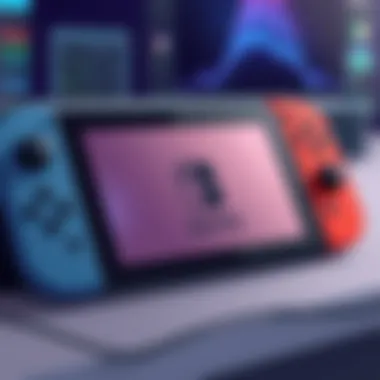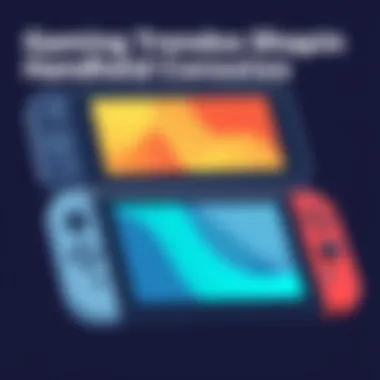Exploring the Best Nintendo Switch Console: Features and Insights


Intro
In the ever-evolving world of gaming, the Nintendo Switch has carved a niche for itself, captivating gamers with its flexible design and robust library of titles. It’s not just a console; it’s a statement of how gaming can adapt to the lifestyles of its players. With multiple iterations since its launch, the question of which version suits your needs best has become an intriguing discussion among enthusiasts. This article aims to dissect the key features, specifications, and overall experience of each model, providing insights into how they fit within the broader gaming landscape.
We'll explore the differences among the various iterations, from the original Switch to the enhanced OLED model, which has brought forth notable improvements. Understanding these distinctions will help you make an informed decision, whether you're a seasoned gamer or someone new to the handheld scene. Furthermore, consider how gaming trends and consumer preferences shape the way we interact with our consoles. As we delve deeper, we aim to present a nuanced view that enlightens while guiding you through this exciting journey.
Key Features
Design and Build Quality
When it comes to design, the Nintendo Switch is a masterclass in versatility. The original model features a sturdy plastic casing and detachable Joy-Con controllers, which provide a unique level of tactile feedback. The design allows users to switch effortlessly between handheld play and TV mode, a quality that has resonated well with gamers seeking flexibility. On the other hand, the OLED version ups the ante with a larger 7-inch display and more refined aesthetics. The screen not only enhances the visual experience during handheld gaming but also boasts vibrant colors that make gameplay pop.
Display and Performance
The display quality is paramount for a shared gaming experience, especially when playing in tabletop mode. The original Switch’s LCD display, while functional, pales in comparison to the OLED’s richer colors and deeper contrasts. The OLED model significantly enhances visual clarity, making it a preferred choice for those who take their gaming seriously. Performance-wise, both models run on the same hardware, but the OLED's improved display really elevates performance in graphic-intensive games, drawing players into the vivid worlds they inhabit.
"A good gaming experience hinges on how well you can connect with its visuals; that’s why the OLED model stands out."
Product Specifications
Technical Specifications
The technical specifications of the Nintendo Switch models lay the groundwork for their capabilities. Here’s a comparative look:
- Original Nintendo Switch
- Nintendo Switch Lite
- Nintendo Switch OLED
- Display: 6.2-inch LCD
- Resolution: 1280x720 (handheld)
- Battery Life: Approximately 4.5 to 9 hours
- Display: 5.5-inch LCD
- Resolution: 1280x720
- Battery Life: Approximately 3 to 7 hours
- Display: 7-inch OLED
- Resolution: 1280x720 (handheld)
- Battery Life: Approximately 4.5 to 9 hours
Understanding these specs is essential to recognize how each model aligns with your gaming habits and preferences.
Compatibility and Connectivity
In terms of compatibility, all models support the same extensive library of Nintendo games, but there are nuances to consider based on connectivity. The original Switch and OLED model both support online multiplayer and local wireless play. The Switch Lite, however, has no TV dock capability, limiting its versatility for those who enjoy shared gaming on a larger screen. Additionally, features such as Bluetooth support and battery longevity play critical roles in how you experience gaming, whether at home or on-the-go.
In closing, as we dissect the features, specifications, and their implications, you will find that there’s no universal answer to which Nintendo Switch model is best. It boils down to personal preferences, gaming styles, and how you envision integrating gaming into your daily life. Let’s continue to unravel this engaging topic.
Prelims to Nintendo Switch
The Nintendo Switch marks a pivotal moment in the evolution of gaming consoles. This hybrid device seamlessly combines home console power with the adaptability of handheld gaming. By delving into what makes the Nintendo Switch unique, we can better understand its position not only in the market but also within gaming culture. Features like its flexibility, robust game library, and multiplayer capabilities play an integral role in its appeal.
A Brief History of Nintendo Consoles
Nintendo has been a household name since the 1980s, known for creating some of the most iconic games and characters in the industry. Prior to the Switch, Nintendo released several consoles that shaped gaming as we know it, including the NES, SNES, Game Boy, Wii, and the Nintendo 3DS. Each of these stints brought innovation and quirky charm.


The NES introduced a whole generation to platform gaming and the joy of co-op play. The Wii, with its motion-sensing controls, drew in casual players who had never gamed before. After the 3DS, Nintendo took a bold leap forward with the Switch, bridging the gap between handheld and home gaming seamlessly. This bold move reflected an understanding of evolving gaming habits and emphasized a flexible approach to play.
What Sets Nintendo Switch Apart?
The Nintendo Switch differentiates itself in several key ways:
- Hybrid Design: Unlike traditional consoles that are either strictly portable or stationary, the Switch allows players to transition between handheld and docked mode without missing a beat.
- Game Library Diversity: From family-friendly titles like Mario Kart 8 Deluxe to indie gems such as Hollow Knight, the Nintendo Switch caters to a broad spectrum of gamers.
- Multiplayer and Social Focus: With simple setups for local multiplayer and a robust online infrastructure, it emphasizes community and shared experiences, aligning with modern gaming trends.
Key Features of the Nintendo Switch
The Nintendo Switch has carved out a unique niche in the gaming world, and it's not just down to good marketing. Its key features are central to understanding why this console is beloved by so many gamers. Flexibility, portability, screen quality, and battery life play massive roles in shaping the user experience.
Flexibility and Portability
One of the standout elements of the Nintendo Switch is its flexibility. Unlike traditional gaming consoles, which often need to be tethered to a TV, the Switch allows you to play wherever and whenever you want. This is especially appealing in today’s fast-paced world. Need to wait for your appointment? Just whip out your console.
Moreover, its portability is designed with the user in mind. The console fits neatly into a small bag, and it can be set up in mere seconds, making it a breeze to play on the go. This aspect is ideal not just for casual players but also for more dedicated gamers who find themselves constantly on the move.
Screen Quality and Performance
Display Resolution
The display resolution of the Nintendo Switch is 1280 x 720 pixels in handheld mode. This is adequate for most games, striking a balance between graphical quality and performance, while the games maintain vibrant colors and clarity. For handheld gaming, this resolution proves to be a solid choice, providing crisp visuals without excessive drain on battery life. Gamers appreciate how the colors pop on the screen, but some might find it lacking when compared to higher-end systems.
Refresh Rate
When discussing the refresh rate, the Switch operates at up to 60Hz for many games. This capability allows for smoother gameplay, particularly in fast-paced titles. A consistent refresh rate can minimize motion blur, giving players a more fluid experience. While it won’t match the 120Hz or higher rates found in some modern consoles, the Switch holds its own quite well, providing good performance that caters to a variety of gaming styles.
Color Accuracy
Color accuracy is another crucial factor. The Nintendo Switch does quite well in depicting vibrant shades and rich depth. Games look impressive, allowing for a fully immersive experience. Users often report an appreciation for the way colors translate, noting it feels more lifelike and engaging than one might expect from a handheld console. However, under direct sunlight or bright light, some users observe reflections that can slightly hinder visibility.
Battery Life Considerations
The battery life of the Nintendo Switch tends to be a mixed bag. On average, players can enjoy anywhere between 4.5 to 9 hours depending on the game and usage. For instance, titles that demand a lot of processing power tend to drain the battery faster. But the flexibility in battery life considerations here is that it allows for a range of play options. Gamers can expect about four hours when playing intense graphics games like "The Legend of Zelda: Breath of the Wild," while simpler choices may yield longer playtime. It's wise for users to consider investing in a portable charger for lengthy trips, especially for those who rely heavily on portable play.
"The flexibility in gaming that Switch offers is a game-changer for many" - A review from a tech enthusiast
Using these features, the Nintendo Switch has managed to maintain robust appeal, drawing in casual gamers, busy parents, and hardcore players alike. Understanding these key characteristics can aid potential buyers in deciding whether this console fits their gaming lifestyle.
Comparing the Nintendo Switch Models
The vast array of options available when it comes to the Nintendo Switch consoles can be a double-edged sword. It’s like being in a candy store with all those choices, but instead of a sugar high, you might end up feeling overwhelmed. Each model has its unique set of features catering to different preferences, making it crucial to sift through the characteristics to find your ideal match. Whether it’s about portability, pricing, or gaming experience, dissecting these differences helps in making informed decisions that align with individual gaming habits and preferences.
Original Nintendo Switch
When it hit the market, the Original Nintendo Switch changed the game in more ways than one. Launched in March 2017, this console stands out for its versatility. It allows users to play in handheld mode, tabletop mode, or docked to the TV, providing a seamless transition between different gaming environments.


The display resolution clocks in at 720p in handheld mode and 1080p when docked, striking a balance between performance and power consumption. One of the more practical aspects of the Original Switch is its detachable Joy-Con controllers, enabling a spontaneous multiplayer experience without requiring any additional controllers.
However, it does have a few drawbacks. Many users have expressed concerns about battery life, which can range from 4.5 to 9 hours, depending on the game being played. Further, the build of the original model is somewhat bulkier, which may hinder the experience for those who prefer ultra-portable devices. The original model's pricing, although competitive, can sway buyers who are sensitive to budget, especially considering newer models with enhanced features.
Nintendo Switch Lite
If you prefer a more streamlined option without the bells and whistles of its older sibling, the Nintendo Switch Lite may catch your eye. Released in September 2019, this model’s primary charm lies in its lightweight design and singular focus on handheld gaming. The Lite caters to a niche audience—those who mainly game on-the-go and don’t mind forgoing the option to dock.
The Lite comes with a 720p screen that's just as capable as the original, yet it sacrifices the detachable Joy-Cons, giving it a more compact, integrated feel. This can be a benefit for some gamers who may appreciate the simplicity of not having to deal with detachable parts.
Nonetheless, it’s not all roses. The lack of TV docking capability and compatibility with certain games that require Joy-Con motion controls can leave some players in the lurch. Battery life, while comparable to the original, hovers around 3 to 7 hours, depending on gameplay. It’s also a more budget-friendly option, making it appealing for casual gamers or families looking to minimize expenses without sacrificing the Nintendo gaming experience.
Nintendo Switch OLED Model
The Nintendo Switch OLED model is an upscale version that was launched in October 2021. If you're someone who appreciates vibrant visuals and high-quality displays, this model might just be the ticket. It retains all the functionalities of the original while enhancing the gaming experience with a 7-inch OLED screen, which provides richer colors and deeper contrast.
The audio quality has seen a noteworthy upgrade, making gameplay in handheld mode a more immersive experience. There’s also a larger internal storage capacity of 64GB compared to the original’s 32GB, allowing for more downloaded games and storage for save data.
On the flip side, this model does come at a higher price point, which may deter budget-conscious gamers. While the gaming experience is notably superior, one must consider if the enhancements are essential for their style of play. Battery life remains similar to the original, ranging from approximately 4.5 to 9 hours, which is a comforting familiarity amidst the newer features.
"Choosing the Nintendo Switch model shouldn’t just be about the latest gizmos; it’s about finding what fits your gaming life best, something that resonates with how you play."
Gaming Experience Across Models
When discussing gaming consoles, the experience encapsulated within each model holds considerable weight. With the Nintendo Switch, the gaming experience is not just about the graphics or performance; it intertwines with aspects such as the available game library, multiplayer functionality, and online support. Each variant of the Switch offers a unique angle, shaping how players interact with the console and the games they cherish. This exploration seeks to illuminate the intricacies of gaming across the different Switch models, helping potential buyers to grasp what they can truly expect.
Game Library and Compatibility
Exclusive Titles
Exclusive titles might just be the crown jewels of any console's library. For the Nintendo Switch, these are more than just games; they are experiences that define the brand. Titles like The Legend of Zelda: Breath of the Wild and Super Mario Odyssey exemplify Nintendo’s creative vision, integrating innovative gameplay mechanics and captivating storytelling. These games are not merely popular but stand as milestones in gaming history, attracting both loyal fans and newcomers alike.
The unique charm of exclusive titles is that they generally leverage the console's hardware capabilities. The switch's versatility allows developers to create immersive worlds that can be enjoyed on-the-go or on a big screen. However, it's worth noting that while these titles are a significant selling point, this exclusivity can also create a divide among users—those who want access to the latest games and those who may not be willing to invest in a new console just for a few standout titles.
Indie Games
Indie games often enter the conversation about gaming experiences with a refreshing twist. They bring creativity without the constraints found in more corporate-driven projects. On the Switch, the indie game ecosystem is flourishing, with releases like Hollow Knight and Stardew Valley gaining traction alongside AAA titles. The contrast they provide is significant; these games often focus on storytelling, art style, and innovative gameplay mechanisms, offering something different compared to more mainstream offerings.
The accessibility of the Switch has attracted indie developers, eager to reach a dedicated audience. One of the striking features of indie games is their variety. Players find themselves in vast worlds filled with unique mechanics, which sometimes overshadow more expansive titles. However, a downside may be that not all indie titles run optimally on the Switch, leading to mixed experiences.
Third-Party Support
Third-party support is another pillar enhancing the Switch's gaming experience. Numerous popular franchises have found a home on Nintendo's platform, expanding beyond Mario and Zelda. Titles like Doom Eternal or The Witcher 3: Wild Hunt show that the Switch can hold its own against more powerful consoles, even if sacrifices had to be made in terms of graphical fidelity or performance.
The variety this support brings is essential for users seeking a fuller gaming experience. It effectively broadens the library, ensuring that players can find something that resonates, whether they enjoy action, adventure, or strategy. Yet, issues such as porting challenges can impact performance and lead to a sometimes compromised experience, which picky gamers might find disappointing.
Multiplayer Capabilities


Multiplayer engagement takes the excitement of gaming to another level. The Switch accommodates various multiplayer modes, from local couch co-op to online matches with friends or strangers across the globe. The design encourages shared experiences, fitting well with the console's portable nature. This social aspect is hugely appealing, allowing players to engage with their friends over a game, whether they are in the same room or miles apart.
Online Services and Support
The online services available for the Nintendo Switch also play a crucial role in the overall gaming experience. Nintendo's suite of services includes the Nintendo Switch Online platform, which offers features such as cloud saves, access to a library of classic titles, and even the ability to play online with others. While not as robust as some competitors, this service adds a layer of depth to the gaming experience, allowing users to fully immerse themselves in the online community. However, it's essential to consider that some users find the service lacking in comparison to the offerings from other major gaming networks, which could affect their overall satisfaction.
In summary, diving into the unique gaming experiences offered by the various Nintendo Switch models reveals an intricate tapestry of exclusive titles, indie gems, third-party support, multiplayer options, and online services. Understanding these elements can guide potential buyers, revealing which model best aligns with their personal gaming preferences and habits.
User Feedback and Community Reception
Understanding user feedback and community reception play a crucial role in the acceptance and longevity of any gaming console, including the Nintendo Switch. This section sheds light on why these factors are essential, delving into the voices of gamers that define the gaming landscape today.
Consumer Reviews and Critiques
Consumer reviews and critiques provide a window into the practical experiences of players with the Nintendo Switch. When buyers take to online platforms, they often share insights based on their enjoyment levels, frustrations, and overall satisfaction with the product. Notably, platforms like Reddit have a wealth of discussions, where gamers openly discuss their preferences, ranging from battery life to the ergonomics of Joy-Con controllers.
Some noteworthy points from user reviews include:
- Joy-Con Drift: This term has become synonymous with complaints regarding control inconsistencies. Gamers have reported instances where their controllers seemingly malfunction, affecting gameplay.
- Game Library: Enthusiasts praise the extensive and unique game library that includes exclusive titles like "The Legend of Zelda: Breath of the Wild" and various Nintendo classics, showcasing not just nostalgia but innovative game design that resonates with both older fans and new players.
- Portability: Many players emphasize the convenience of transitioning from handheld to docked mode. They appreciate the flexibility, particularly for those who enjoy gaming while on-the-go.
Such critiques give an indication of what works and what doesn’t from a user perspective, assisting potential buyers in making informed decisions. Brands can garner valuable insights from these experiences to enhance their products.
Impact on the Gaming Community
The Nintendo Switch’s reception has significantly influenced the gaming community. It’s more than just a console; it’s a cultural phenomenon. For many, it sparked a revival in local multiplayer games and gatherings. Players found themselves drawing together in living rooms, sharing experiences that harken back to retro gaming days, a fact that resonates well in today’s often isolated gaming world.
Moreover, the Switch has pushed developers to think outside the box. Indie developers have seized the opportunity to create engaging titles suited for the hybrid console. Popular indie games like "Hollow Knight" and "Celeste" have found eager audiences, proving that the Switch is not just a platform for major franchises but a fertile ground for unique gaming experiences.
"The magic of the Nintendo Switch lies in its ability to connect people, as much as it connects to online experiences. It’s not just about the games; it’s about the moments spent together that matter most."
Additionally, it has reinforced the importance of gamer feedback in shaping future products. As developers listen and respond to their communities, it has created a cycle of improvement and trust that can only benefit the gaming industry moving forward. Closing this loop of feedback fosters innovation in hardware as well as in game design, setting a new standard for engagement between gamers and developers.
Culmination: Choosing the Best Console
As the landscape of gaming continues to evolve, the mere act of picking the right console becomes a nuanced task. In this article, we sifted through various aspects of the Nintendo Switch, assessing its features, models, and user experiences. Understanding the distinctions in performance and capabilities across the different models can help potential buyers make informed decisions that cater to their specific needs and lifestyles.
When considering the Nintendo Switch, it's paramount to weigh factors such as how you intend to use the console, be it for on-the-go gaming or a more stationary traditional experience. Not all players are cut from the same cloth, and preferences can vary wildly. Some might prioritize handheld convenience, while others may seek a display that really brings games to life on a bigger screen.
Evaluating Personal Needs
Every gamer comes with their unique set of priorities. Evaluating personal needs is like looking in a mirror; what do you truly want from your gaming experience? Here are key points to consider:
- Gaming Style: Casual players may find the Nintendo Switch Lite perfectly adequate, while hardcore gamers might lean toward the original or OLED models for enhanced performance.
- Portability vs. Power: If you're constantly on the move, understanding the significance of a lightweight, portable device could tip the scales towards the Switch Lite. However, if you value higher fidelity graphics and a larger screen, the OLED might be more your style.
- Multiplayer Options: If family or friends are part of your gaming equation, consider how each model's multiplayer capabilities mesh with your social gaming plans.
Evaluating personal needs provides a comprehensive insight into how different Nintendo Switch models align with your gaming habits. The potential for customization, or finding a model that captures your preferences, is not just a convenience; it’s a pathway to enjoyment.
Future Prospects in Gaming Consoles
As we glance into the crystal ball, the future of gaming consoles appears both promising and complex. The rise of hybrid systems, like the Nintendo Switch, hints at a shift towards more adaptable gaming experiences. Here are some potential developments to ponder:
- Enhanced Technology: Advancements in graphics and processing power are inevitable, paving the way for consoles that deliver even further immersive experiences.
- Integration of Virtual Reality: Could the next iteration of Nintendo consoles include more robust VR compatibility? This technology’s evolution may redefine how players interact with their games, making it a worthwhile area to keep an eye on.
- Sustainability Considerations: With growing awareness of environmental impact, future consoles might adopt more eco-friendly materials and technologies to reduce their footprint.
The right choice today is the foundation for a fulfilling gaming experience tomorrow.



